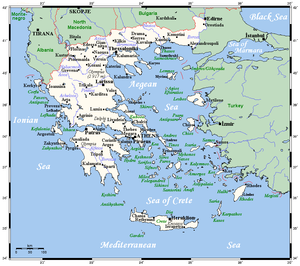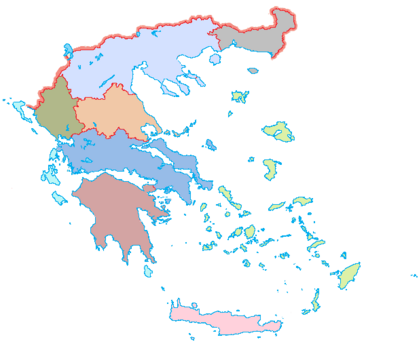This is an old revision of this page, as edited by 208.71.79.254 (talk) at 19:53, 11 December 2024. The present address (URL) is a permanent link to this revision, which may differ significantly from the current revision.
Revision as of 19:53, 11 December 2024 by 208.71.79.254 (talk)(diff) ← Previous revision | Latest revision (diff) | Newer revision → (diff)
| This article includes a list of general references, but it lacks sufficient corresponding inline citations. Please help to improve this article by introducing more precise citations. (February 2023) (Learn how and when to remove this message) |
{{Country geography
|name= Greece
|map = Greece MODIS Terra Satellite Image 19 Aug 2004.jpg
|continent =Europe
|region = South Europe
|coordinates = 39°00′N 22°00′E / 39.000°N 22.000°E / 39.000; 22.000
|area ranking = 95th
|km area = 131,957
|percent land = 99.13
|km coastline = 13,676
|borders = 689.76 km (428.60 mi)
|highest point = Mount Olympus
2,918 metres (9,573 ft)
|lowest point = Epitalio
−6 metres (−20 ft)
|longest river = Haliacmon
297 kilometres (185 mi)
|largest lake = Lake Trichonida
98.6 km (38.07 sq mi)
|terrain = 80% mountainous, plains (east and north-east)
|natural resources = petroleum, magnetite, lignite, bauxite, hydropower, marble, limestone, fish
|natural hazards = earthquakes, floods, droughts and wildfires
|environmental issues = air
Plains are found in eastern Thessaly, in central Macedonia and in Thrace.
Elevation extremes
- Highest point: Mount Olympus: 2,917 m (9,570 ft)
- Lowest point: Epitalio: −6 m (−20 ft)
Extremities of Greece
The extreme points of Greece are
- North: Ormenio village (41°45′41″ N, 26°13′15″ E)
- South: Gavdos island (34°48′11″ N, 24°07′25″ E)
- East: Strongyli island (36°06′17″ N, 29°38′39″ E)
- West: Othonoi island (39°51′11″ N, 19°22′41″ E)
Natural resources
Greece has notable deposits of petroleum, magnetite, lignite, bauxite, hydropower, marble, limestone Ancient Greeks used limestone as a durable building material in many buildings such as the Parthenon. Greece has substantial marine life with plentiful fish in its EEZ.
Land use
- Arable land: 19.71%
- Permanent crops: 8.95%
- Other: 71.37% (2012 est.)
Irrigated land: 15,550 km (2007)
|
|
| Cities and islands of Greece |

Mainland
Mainland Greece forms the southernmost part of the Balkan peninsula with two additional smaller peninsulas projecting from it: the Chalkidiki and the Peloponnese. The north of the country includes the regions of Macedonia and Thrace. To the south the mainland narrows and includes the regions of Epirus, Thessaly and Central Greece, where the region of Attica and the capital city Athens are located. Further south, the smaller peninsula of Peloponnese is separated from the rest of the Greek mainland by the Corinthian and Saronic Gulfs, but joined by the Isthmus of Corinth.
Mainland Greece covers about 80% of the total territory and is largely mountainous. The largest mountain range of Greece is the Pindus range, the southern extension of the Dinaric Alps, which forms the spine of the Greek mainland, separating Epirus from Thessaly and Macedonia. The country's tallest mountain is Mount Olympus, which also separates Thessaly from Macedonia. Its highest peak rises to 2,918 m above sea level, making it the second highest of the Balkan peninsula after Musala in the Rila Mountain.
The number of islands vary between 1,200 and 6,000. A figure frequently cited in travel guides is 1,425 islands, of which 166 are said to be inhabited. The Greek Tourism Organization reports a figure of 6,000, with 227 of them inhabited. Paris Match, however, raises this number to 9,841 islands, of which only 169 have a recorded continuous human presence.
The Greek islands account for about 20% of the country's total territory, and vary greatly in size as well as in climate. The country's largest island is Crete, with Euboea being second largest. Other large Greek islands include Rhodes and Lesbos in the Aegean Sea, and Corfu and Cephalonia in the Ionian Sea. Many of the smaller Greek islands form groups or chains, often called archipelagos, with notable examples being the Cyclades and the Sporades in the south and central Aegean Sea respectively.
Aegean
Main articles: Aegean Islands, Aegean Sea, and List of Aegean IslandsThe islands of the Aegean Sea are situated between mainland Greece to the west and north, Anatolia to the east and the island of Crete to the south. Traditionally, the islands are classified into seven groups, from north to south:
- North Aegean Islands
- Sporades
- Euboea
- Saronic Islands
- Cyclades
- Dodecanese (Southern Sporades)
- Crete
Ionian Islands
Main article: Ionian IslandsThe Ionian Islands are a group of seven islands. The six northern islands lie off the western coast of Greece, in the Ionian Sea. The other island, Kythira, lies off the southern tip of the Peloponnese. Kythira is part of the modern administrative region of Attica, not the Ionian Islands (Ionioi Nisoi). The Ionian Islands are distinct from the historical region of Ionia, which is today part of western Turkey.
Crete
Crete is the largest island of Greece and the second largest in the Eastern Mediterranean, after Cyprus. The island spans 260 km from east to west and 60 km from north to south at its widest. The island narrows in the region close to Ierapetra, where it is only 12 km wide. Crete covers an area of 8,336 km (3,219 sq mi), with a coastline of 1046 km. It is surrounded to the north by the Sea of Crete; to the south by the Libyan Sea; to the west by the Myrtoan Sea; and to the east by the Karpathion Sea. It lies about 160 km south of the Greek mainland.
Crete is characterized by a mountain range crossing from west to east, formed by three different subranges:
- The White Mountains or Lefka Ori (2,452 m);
- The Idi Range (Psiloritis (35°11′N 24°49′E / 35.18°N 24.82°E / 35.18; 24.82) 2,456 m);
- The Dikti Mountains (2,148 m)
These encompass fertile plateaus, such as Lasithi, Omalos and Nidha; caves such as Diktaion and Idaion; and gorges such as the Samariá Gorge. The protected area of the Samariá Gorge is the home of the Cretan goat, or kri-kri, while the endangered Bearded vulture or lammergeyer lives in the Cretan mountains and gorges.
Crete's rivers include the Ieropotamos River in the southern part of the island.
-
Crete (NASA photograph)
Environment

Greece is a mostly mountainous country with a very long coastline, filled with peninsulas and islands.
The climate can range from semi-desert to cold climate mountain forests.
Greece's natural hazards include severe earthquakes, floods, droughts and wildfires. Current environmental issues in Greece include air pollution and water pollution.
Climate

The climate of Greece is mild. A Mediterranean climate prevails on the coast and islands, and a Continental climate prevails in the mountainous regions of the interior. Summers are hot and dry and winters are cool and humid. Summer is rainless and the almost cloudless season lasts about three months. In July and August, the temperature usually rises to around 30–35 °C and even above 40 °C. In the eastern part of the country and especially in the archipelago, a cooling Etesian wind blows in the summer, but in big cities like Athens it can get sweltering hot. The wind can be very strong at times, which makes sailing difficult.
A special feature of Greek weather is the high amount of sunshine. It is available for five hours even in winter, and up to 12–14 hours a day in summer. The rains mostly occur in winter. Snow can be found everywhere in Greece, but it is rare in the archipelago. In low-lying areas, snow hardly ever stays on the ground. On the tops of the highest mountains, snow remains well into the summer. Spring and autumn are short in-between seasons when the weather is variable.
Extensive forest fires cause problems almost every year in late summer. Sometimes they lead to widespread evacuations and even deaths.
Gallery
-
 Mount Olympus
Mount Olympus
-
 Volcanic crater, Santorini
Volcanic crater, Santorini
-
 Achelous River
Achelous River
-
 Taygetus (Mountain Range)
Taygetus (Mountain Range)
-
 Pindus National Park
Pindus National Park
-
 Vikos–Aoös National Park
Vikos–Aoös National Park
-
 Samariá Gorge
Samariá Gorge
-
Kremasta (lake)
-
Mount Pelion
-
 Potidea Kanal, Chalkidiki
Potidea Kanal, Chalkidiki
-
 Manganari beach, Ios (island)
Manganari beach, Ios (island)
-
 Landscape of Stymfalia with Mount Kyllini
Landscape of Stymfalia with Mount Kyllini
-
 Palm beach of Vai (Crete)
Palm beach of Vai (Crete)
-
 Navagio, Zakynthos
Navagio, Zakynthos
-
 Mount Parnassus
Mount Parnassus
See also
- Geography of Europe
- Greek names of mountains
- List of earthquakes in Greece
- List of islands of Greece
- National parks of Greece
- Wildlife of Greece
References
- "Greece topographic map". Retrieved 16 February 2023.
- ^ "Η ιστορία των μετ.σταθμών της Ε.Μ.Υ στη Νέα Φιλαδέλφεια". Meteoclub. 12 August 2011. Archived from the original on 18 January 2022. Retrieved 16 February 2023.
- ^ "Geography of Greece". Greeka. 11 May 2014. Archived from the original on 5 April 2024. Retrieved 27 April 2024.
- ^ CIA. "Greece Country Summary". The World Factbook. CIA. Archived from the original on 19 January 2024. Retrieved 27 April 2024.
- "Statistical Yearbook of Greece 2009 & 2010" (PDF). Hellenic Statistical Authority. p. 27. Archived from the original (PDF) on 13 December 2013.
- "Limestone Through The Years". Impression. 27 June 2022. Archived from the original on 3 June 2023. Retrieved 27 April 2024.
- Cite error: The named reference
searounduswas invoked but never defined (see the help page). - Marker, Sherry; Kerasiotis, Peter (2010). "Greece in depth". In Nadeau, Mark (ed.). Frommer's Greece. Hoboken: Wiley. p. 12.
- Poffley, Frewin (2002). Greek Island Hopping. Thomas Cook. p. 15.
- Ellinikos Organismos Tourismou (EOT). "Greek islands". Archived from the original on 3 June 2012. Retrieved 29 April 2012.
- "Top 5: Les plus belles îles grecques". Paris Match. 28 July 2016. Archived from the original on 21 October 2023. Retrieved 28 April 2024.
- Treves, Tullio; Pineschi, Laura (January 1997). The Law of the Sea. ISBN 9041103260.
- "Country Guide Greece". BBC Weather. Archived from the original on 9 February 2011.
- "Greece". Weather Online. 9 April 2024. Archived from the original on 9 April 2024.
Further reading
![]() This article incorporates public domain material from The World Factbook. CIA.
This article incorporates public domain material from The World Factbook. CIA.
| Geography of Europe | |
|---|---|
| Sovereign states |
|
| States with limited recognition | |
| Dependencies and other entities | |
| Other entities | |

